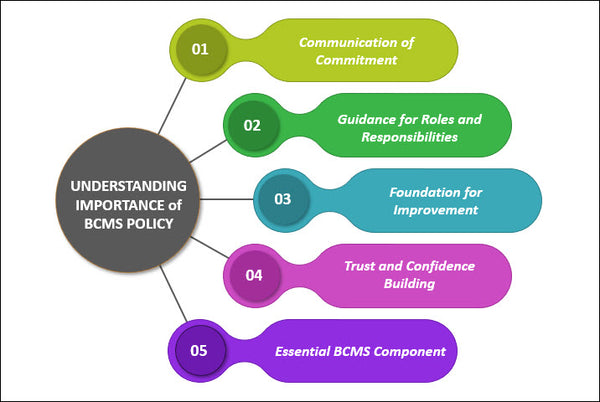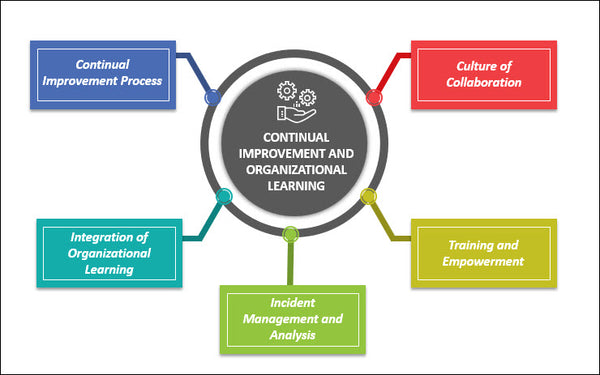Objectives of the BCMS Policy in ISO 22301
Implementing an effective Business Continuity Management System (BCMS) is crucial for organizations to ensure resilience and minimize disruptions during unexpected events. ISO 22301 provides the framework for establishing and maintaining a BCMS, and an integral part of this system is the BCMS Policy. The BCMS Policy outlines the objectives and direction of the organization's business continuity efforts, serving as a guide for all employees and stakeholders. In this blog post, we will delve into the objectives of the BCMS Policy in ISO 22301 and explore its significance in safeguarding organizational continuity.

Understanding the Importance of a BCMS Policy
A BCMS Policy plays a crucial role in the successful implementation and maintenance of a Business Continuity Management System (BCMS). It serves as a foundational document that outlines the objectives and direction of an organization's business continuity efforts.
- One of the primary objectives of a BCMS Policy is to ensure that all employees and stakeholders are aware of the organization's commitment to business continuity. By clearly communicating the importance of business continuity and the organization's goals in this regard, the BCMS Policy helps to create a culture of preparedness and resilience throughout the organization.
- The BCMS Policy also serves as a guide for employees when it comes to their roles and responsibilities in relation to business continuity. It helps to define the actions and procedures that need to be followed in the event of a disruption or crisis. By providing this guidance, the BCMS Policy helps to ensure that everyone is aligned and working towards the same goals, thus minimizing confusion and reducing the risk of errors during critical situations.
- Furthermore, the BCMS Policy helps to establish a framework for continuous improvement in business continuity. It sets the foundation for regular reviews and updates of the BCMS, ensuring that it remains relevant and effective in addressing emerging threats and challenges. By fostering a culture of ongoing assessment and improvement, the BCMS Policy helps organizations to stay proactive and adaptive in the face of changing circumstances.
- Another important aspect of the BCMS Policy is its role in building trust and confidence among stakeholders. By outlining the organization's commitment to maintaining operational resilience and minimizing disruptions, it demonstrates a proactive approach to risk management. This can have a significant impact on stakeholders' perceptions of the organization's reliability and trustworthiness, enhancing its reputation and competitive advantage.
- The BCMS Policy is a fundamental component of an effective BCMS. It sets the objectives and direction of an organization's business continuity efforts, provides guidance for employees, and establishes a framework for continuous improvement. By emphasizing the importance of business continuity and fostering a proactive approach to risk management, the BCMS Policy contributes to the organization's overall resilience and ability to navigate unexpected events.
Building Trust and Confidence Among Stakeholders
- Building trust and confidence among stakeholders is a critical objective of the BCMS Policy in ISO 22301. The BCMS Policy serves as a foundational document that outlines an organization's commitment to business continuity and its goals in this regard.
- By clearly communicating the organization's dedication to maintaining operational resilience and minimizing disruptions, the BCMS Policy helps to instill trust and confidence among stakeholders. When stakeholders see that the organization has a proactive approach to risk management and is actively working to ensure business continuity, they are more likely to view the organization as reliable and trustworthy.
- Trust and confidence are essential for the success of any organization. Stakeholders, including customers, clients, investors, and partners, want to have assurance that the organization is prepared to handle unexpected events and can continue to deliver products or services without major interruptions. The BCMS Policy plays a crucial role in building and maintaining this trust.
- When stakeholders have confidence in the organization's ability to manage and mitigate risks, they are more willing to engage in business relationships and investments. They are more likely to choose the organization over competitors and recommend it to others. This can have a significant impact on the organization's reputation and competitive advantage.
- Furthermore, the BCMS Policy helps to demonstrate transparency and accountability to stakeholders. By outlining the actions and procedures that need to be followed in the event of a disruption or crisis, the BCMS Policy provides stakeholders with a clear understanding of how the organization will handle such situations. This transparency helps to build confidence and reduces the risk of misunderstandings or miscommunications during critical situations.
- In addition to building trust and confidence among external stakeholders, the BCMS Policy also fosters a sense of trust and confidence within the organization itself. When employees see that the organization is committed to their safety and well-being, as well as the continuity of operations, they are more likely to feel valued and motivated. This can lead to increased productivity and loyalty among employees, further enhancing the organization's overall resilience.
Building trust and confidence among stakeholders is a key objective of the BCMS Policy in ISO 22301. By clearly communicating the organization's commitment to business continuity, providing guidance for employees, and fostering a proactive approach to risk management, the BCMS Policy helps to establish the organization as reliable, trustworthy, and resilient. This can have a positive impact on the organization's reputation, competitiveness, and overall success.
Continual Improvement and Organizational Learning
Continual improvement and organizational learning are essential objectives of the BCMS Policy in ISO 22301. A successful business continuity management system (BCMS) requires a culture of continual improvement and a commitment to organizational learning.

- Continual improvement involves identifying areas for improvement, setting objectives, implementing changes, and monitoring progress. It is a cyclical process that aims to enhance the effectiveness and efficiency of the BCMS. By regularly reviewing and improving the BCMS, organizations can better prepare for and respond to disruptions, minimize downtime, and reduce the impact of incidents.
- Organizational learning goes hand in hand with continual improvement. It involves the acquisition, interpretation, and application of knowledge gained from past experiences. By reflecting on previous incidents and near misses, organizations can learn valuable lessons and develop strategies to prevent or mitigate future disruptions. This knowledge is then integrated into the BCMS, ensuring that the organization is better prepared for future challenges.
- One way to facilitate organizational learning is through incident management and post-incident analysis. When incidents occur, it is crucial to conduct thorough investigations to understand the root causes and identify areas for improvement. This includes analyzing the effectiveness of response measures, identifying gaps in preparedness, and assessing the performance of the BCMS as a whole. By conducting these analyses, organizations can learn from their mistakes and implement corrective actions to prevent similar incidents from reoccurring.
- Organizational learning also involves training and education. By providing employees with the necessary knowledge and skills, organizations empower them to contribute to the effectiveness of the BCMS. Training programs should cover topics such as incident response, business continuity planning, and risk management. By ensuring that employees are well-informed and trained, organizations can build a resilient workforce that is capable of effectively responding to disruptions.
- Furthermore, continual improvement and organizational learning require a culture of openness and collaboration. It is essential to encourage employees at all levels to actively participate in the improvement process. This can include providing avenues for employees to share their insights, suggestions, and lessons learned. By fostering a culture of learning and collaboration, organizations can tap into the collective wisdom of their workforce and identify innovative solutions to improve the BCMS.
Continual improvement and organizational learning are critical objectives of the BCMS Policy in ISO 22301. By embracing a culture of improvement and learning, organizations can enhance the effectiveness of their BCMS, minimize the impact of disruptions, and build a resilient and confident workforce. This commitment to continuous improvement ensures that the organization remains adaptable and prepared for the evolving challenges of the future.
Conclusion
The objectives of the BCMS Policy in ISO 22301 are focused on continual improvement and organizational learning. By actively seeking areas for improvement, setting objectives, implementing changes, and monitoring progress, organizations can enhance the effectiveness and efficiency of their business continuity management systems.
Overall, continual improvement and organizational learning are critical for building a resilient and confident workforce and ensuring that organizations remain adaptable and prepared for the evolving challenges of the future. By embracing these objectives, organizations can enhance their BCMS, minimize the impact of disruptions, and maintain a competitive edge in today's rapidly changing business landscape.



